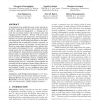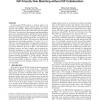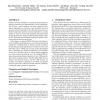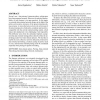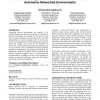CONEXT
2008
ACM
14 years 1 months ago
2008
ACM
A foundational issue underlying many overlay network applications ranging from routing to peer-to-peer file sharing is that of connectivity management, i.e., folding new arrivals ...
CONEXT
2008
ACM
14 years 1 months ago
2008
ACM
Modeling the Internet delay structure is an important issue in designing large-scale distributed systems. However, linear models fail to characterize Triangle Inequality Violation...
CONEXT
2008
ACM
14 years 1 months ago
2008
ACM
Modern commodity hardware architectures, with their multiple multi-core CPUs and high-speed system interconnects, exhibit tremendous power. In this paper, we study performance lim...
CONEXT
2008
ACM
14 years 1 months ago
2008
ACM
Abstract: Social virtual worlds such as Second Life are digital representations of the real world where human-controlled avatars evolve and interact through social activities. Unde...
CONEXT
2008
ACM
14 years 1 months ago
2008
ACM
In peer-to-peer (P2P) systems, a receiver needs to be matched with multiple senders, because peers have limited capacity and reliability. Efficient peer matching can reduce the co...
CONEXT
2008
ACM
14 years 1 months ago
2008
ACM
Overlay networks create new networking services across nodes that communicate using pre-existing networks. MOSAIC is a unified declarative platform for constructing new overlay ne...
CONEXT
2008
ACM
14 years 1 months ago
2008
ACM
Increased AP density in enterprise WLANs leads to increasing RF interference and decreasing performance. An important step towards mitigating this problem is to construct precise ...
CONEXT
2008
ACM
14 years 1 months ago
2008
ACM
Chronic network conditions are caused by performance impairing events that occur intermittently over an extended period of time. Such conditions can cause repeated performance deg...
CONEXT
2008
ACM
14 years 1 months ago
2008
ACM
Several new, data-oriented internetworking architectures have been proposed recently. However, the practical deployability of such designs is an open question. In this paper, we c...
CONEXT
2008
ACM
14 years 1 months ago
2008
ACM
